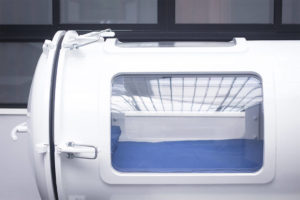Hyperbaric Oxygen Therapy (HBOT) for Treating Children Born with Cerebral Palsy

Hyperbaric Oxygen Therapy & CP
Hyperbaric Oxygen Therapy (also known as HBOT) is a medical procedure that involves delivering 100% pure oxygen to the patient through the use of a controlled pressurized chamber (usually for about 90 minutes at a time). A typical phase of treatment will include over three dozen separate sessions.
HBOT increases the oxygen in the blood by ~2000%, and increases the level of oxygen at the cellular level. This is done in an attempt to revive damaged brain cells in newborn children who suffered hypoxia or asphyxiation during a problematic delivery. There is considerable debate whether or not hyperbaric oxygen therapy is effective, with some claiming that such treatment can actually be harmful.
How Does HBOT Affect Those with Cerebral Palsy?
Cerebral palsy disrupts the brain’s ability to control the movement of the body’s muscles, and is the result of damage to different motor areas of the developing brain due to a lack of blood flow (oxygen). When a baby’s brain is deprived of oxygen for several minutes at a time during delivery, it can lead to swelling in the brain and tissue death.
Hyperbaric oxygen therapy seeks to remedy this by increasing the amount of oxygen in the newborn’s blood by up to 2000 percent, which increases the amount of oxygen in the actual cells of the body. Proponants of HBOT claim that this increase in oxygen helps white blood cells kill bacteria, reduces swelling in the brain, and helps new blood vessels grow in damaged areas.
HBOT has been shown to aid in tissue swelling, and some experts believe that secondary (dormant) areas of the brain may be revived through this form of therapy. There is evidence that shows HBOT can work for stroke patients, and several families have claimed that HBOT helped their child in areas such as spasticity, vision, and speech.
Are There Risks to HBOT?
Yes there are risks, but they tend to be minimal. Minor discomfort of the ears is a common side effect, but there is a risk of permanent ear damage. One 2006 study (involving 111 children with CP) states that short-term exposure to hyperbaric oxygen at medium level pressure (1.75 atm abs) was responsible for a significant increase of middle ear barotrauma compared to children that received very low external pressure (1.3 atm abs). The same study noted that no injuries occurred due to oxygen toxicity.
Does It Work?
While proven effective for conditions such as carbon monoxide poisoning and decompression sickness, it’s important to understand that hyperbaric oxygen therapy is considered experimental treatment when it comes to cerebral palsy.
Medical professionals who believe that this therapy can help sufferers of cerebral palsy say that it is a viable treatment, while opponents caution that HBOT may not offer any benefits at all. Most believe that more research needs to be conducted.
The Department of Health & Human Services released a report in 2003 addressing hyperbaric oxygen therapy for infants with cerebral palsy, and after a through review of research studies and literature, the treatment remains unproven – a giant question mark. An article from the journal Pediatrics in 2000 goes as far as to suggest a correlation between hyperbaric oxygen therapy and adverse effects in children with cerebral palsy.
In a 2013 article by Novak and Badawi, researchers concluded that “hyperbaric oxygen (HBO) was not effective in improving Gross Motor Function Measure (GMFM) scores, and was no more effective than pressurized air (HBA) in improving Pediatric Evaluation of Disability Inventory (PEDI) scores. These results do not support use of HBO as a therapy for cerebral palsy in young children who did not have neonatal hypoxic-ischemic encephalopathy.”
Is Hyperbaric Oxygen Therapy Right for My Child?
The biggest complaint families often have following hyperbaric oxygen therapy is that they’re often unsatisfied with the results. Most patients are hoping for a miracle treatment, but may not see immediate success (or any improvement for that matter).
So what’s a parent to do? Research, research, research, and consult your child’s doctor for their expert medical opinion.
